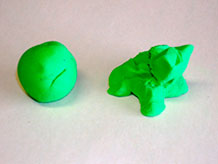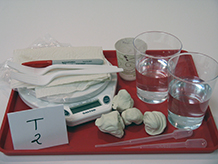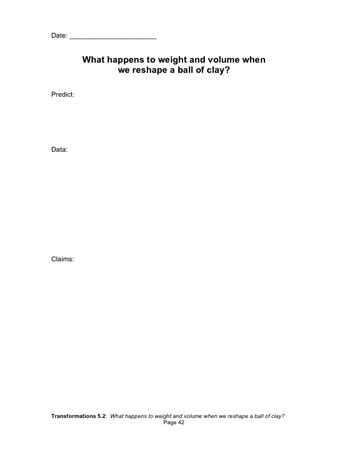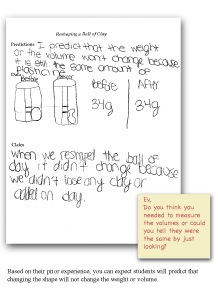What happens to weight and volume when we reshape a ball of clay?
Plan Investigation 5.2

What if we take a ball of plastic modeling clay and mold it into the shape of an elephant? Does the weight stay the same? Does the volume?
Formative Assessment
Available online at inquiryproject.terc.edu
In this investigation, a companion piece for the previous one, students continue to explore what happens when earth materials are transformed. Instead of crushing shells, students this time manipulate a ball of plastic modeling clay, which serves as a stand-in for clay, a malleable earth material. Students record the weight and volume of a ball of plastic modeling clay, form it into a new shape of their own choosing, and then measure weight and volume again.
By the end of this investigation students will understand that plastic modeling clay or clay retains its weight and volume no matter what shape it assumes.
Learning Goals
- Discover what happens to weight and volume when clay changes shape
| Sequence of experiences | ||
|---|---|---|
| 1. Ask the question | All Class | 5 Mins |
| 2. Explore weight and volume | Pairs | 25 Mins |
| 3. Make meaning | Discussion | 15 Mins |
Materials and Preparation

- Post the investigation question in a place where all students can see it.
- 1 tray of materials, as below, for class discussion
- 1 fine-tip permanent marker
- 1 digital scale
- 1 3oz cup of water
- 2 20oz cups approximately half full of water
- 2 forks
- 2 pipettes
- 4 balls of plastic modeling clay, approximately 30g each
- 4 paper towels
Notebook Pages
Do students understand that a ball of plastic modeling clay will weigh the same and displace the same volume of water no matter how it is reshaped?
The notebook will provide you with evidence of students’ understanding. Criteria you can use to interpret the entries are; Do students:
- predict that weight and volume will stay the same?
- use their measurements to support their claims?
- reason that if you don’t add plastic modeling clay or take it away, weight and volume should stay the same?
- do their measurements seem accurate?
Students may find small changes in weight (+/- 1 gram) after reshaping. Do students think this difference is significant? As a next step, you might look at class data and discuss possible sources of error such as inaccurate scales or forgetting to dry off the reshaped plastic modeling clay.







